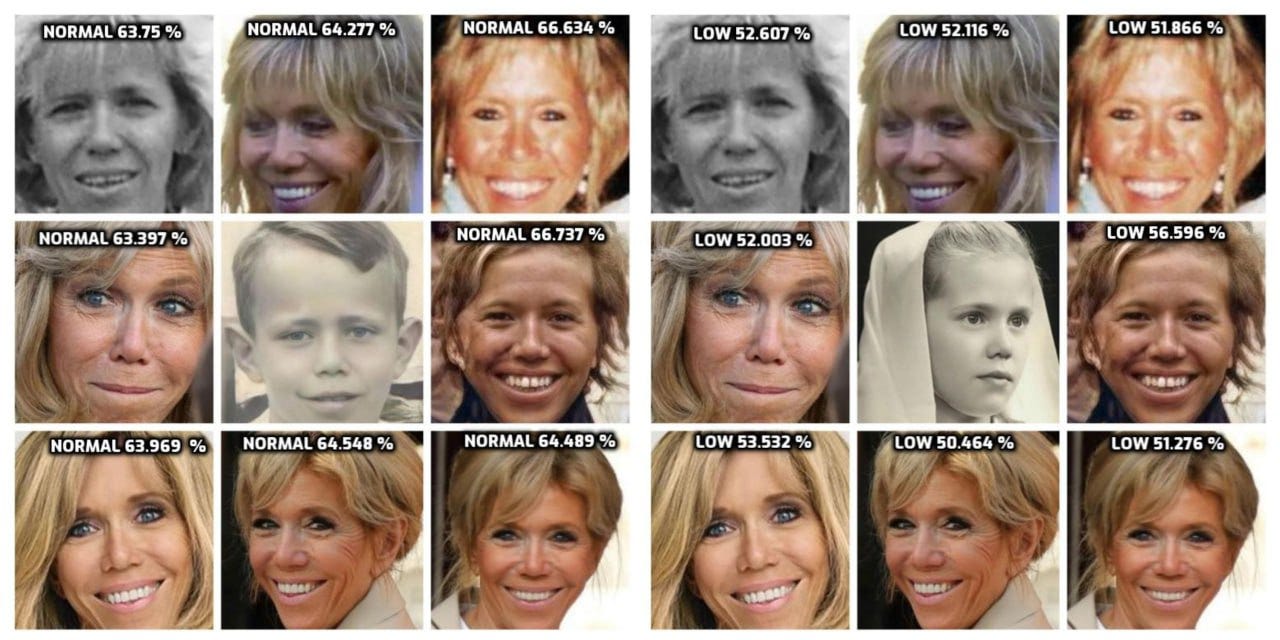BRI-SP: The facial recognition
Part 7: If China can identify 1.5 billion Chinese with software, could it not recognise Brigitte and Jean-Michel Trogneux?
From very early on, Pressibus started to compare pictures using the Betaface software.
Later on, Xavier Poussard purchased Megvii’s Face++ software for his comparisons, one of the best on the market at that moment, and used by the Chinese government.
Even though the results differ, there are clear conclusions to be drawn, especially from the Face++ comparisons. However, these comparisons are not magic wands, and to understand their value, we need to keep the following in mind:
facial recognition works with distances between facial features, mainly bone structure, as it is very difficult to change it
comparisons depend on the quality of the picture: the best way to use facial recognition software is by looking straight into the camera, like is required for passport pictures
this means that the more a person is seen in profile, the less usable the picture is for facial recognition
it also means that glasses make a picture as good as unusable: the glasses cover a big area of the face, especially cheeks eye sockets, eye brows, eyes and nose base, which are crucial points for a good comparison
comparisons between adults gives the best results, for the same obvious reasons: the skull is fully formed and won’t change anymore
the results are not conclusive proof, but give a clear indication, and more in the negative sense: it is easier to show that someone is not the person in another picture than that he/she is the person in another picture
it is known that Brigitte Macron has undergone surgery by a surgeon specialised in ‘facial feminisation’, which may have altered some of her facial bone structure
The Betaface results are less reliable than the Face++ results.
Xavier Poussard considers the following results conclusive:
Brigitte Macron is not the Brigitte Trogneux in the communicant and wedding pictures
le ‘Petit Gros’ is not the Jean-Michel Trogneux in the family and school pictures
Pressibus has raised a serious question about Xavier Poussard’s claim that Face++ would be used by the Chinese government to differentiate between nearly 1.5 million Chinese citizens. If this software is used to know who is seen on ‘security’ cameras all over public spaces, then obviously, glasses cannot be considered an obstacle. Because loads of Chinese wear glasses, and are they then not recognised? It would also mean that putting on glasses would be enough to disguise yourself from facial recognition. That seems absurd. Online information agrees with Pressibus that glasses would not make the software unusable, and that it can effectively recognise people with glasses on.
My own experience with a facial recognition punch clock is that indeed, people with glasses have to take them off for the machine to readily recognise the faces. Of course, the software used in this machine will be of much lower quality than Face++.
Maybe one of the biggest points to keep in mind here is that we are comparing different performances. Facial recognition software is normally used live, or through video footage. In other words: with moving faces, giving different angles of the face of one single person. We can also assume that the Chinese government has a database with the vast majority of their citizens’ faces, saved as 3D masks. This database is then used to compare what is seen on cameras with.
Picture comparison, on the other hand, gives only one still frame of a certain face, making it impossible for the software to get a 3D view of the face.
I think this is a major difference. From my own experience, the registration process for a biometric machine takes moving your face slightly in all directions so that different angles are recorded and a sort of 3D mask is created, that can then recognise you when you stand in different positions.
When this software is used to make a comparison between two pictures, with no database of confirmed pictures or a 3D mask to compare any of the pictures with, the task becomes a very different one – and basically, it is not the task that the software was created for. And thus the performance of a certain software when comparing pictures should logically be very different from the performance when doing live or video recognition based on an established database.
It will be needed to keep all these aspects in mind, for each person to decide for themselves what value they attach to the results of the facial recognition.
From what I can see, it seems that doing loads of tests with known persons and pictures will give the best experience to gauge the result of comparisons: it’s the fact of having seen a ton of results with different pictures (b/w vs colour, profile vs straight, young vs old, glasses vs no glasses etc.) that will make someone know the value of the percentages.



